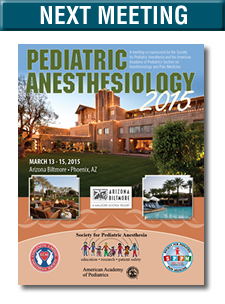asa meeting reviews
Anesthetic Safety in Newborns Can Be Achieved by Sticking to Little Details
By Kate Gentry, MD
Seattle Children’s Hospital
This clinical forum was moderated by Susan Verghese, MD (Children’s National Medical Center) and featured three case presentations: 1) a premature infant with T21 for duodenal atresia repair; 2) a term infant with Beckwith Wiedemann Syndrome for omphalocele repair; and 3) a 33-week preterm infant with VACTERL presenting for TEF repair. The neonatal physiology and pharmacology relevant to each case was reviewed, and each speaker highlighted pertinent clinical pearls. A Q&A session followed the presentations.
The first presenter was Senthilkumar Sadhasivam, MD, MPH (Cincinnati Children’s Hospital Medical Center). His lecture commenced with a discussion of cardiovascular issues in an infant with Down Syndrome (T21), focusing on the transitional circulation and the potential for flow reversal, for which a pre-operative ECHO is indicated. Bradycardia—a particular risk on induction in T21 patients—is undesirable in the neonate, given the reduced myocardial contractility and ventricular compliance in this age group.
The speaker recommended IV atropine after pre-oxygenation, gastric decompression with a red rubber catheter in supine, right and left lateral decubitus positions, followed by a rapid sequence induction and placement of a cuffed endotracheal tube. He endorsed use of the Microcuff tube, which has a smaller cuff at the very distal end of the ETT, and lacks a Murphy eye. Manual in-line stabilization of the neck was recommended given the risk of atlanto-occiptal instability in the T21 population.
Also noted was the risk of post-operative apnea, for which the following risk factors were listed: prematurity, anemia (HCT<30), general anesthesia (as opposed to regional), opioids, other comorbidities, and the surgical procedure. Methods suggested for reducing risk of apnea included opioid-sparing techniques, regional anesthesia, IV acetaminophen (despite lack of FDA approval for neonates), caffeine (10 mg/kg), correction of anemia, and attentive post-operative respiratory monitoring.
The second case, discussed by Carolyn Bannister, MD (Children’s Hospital at Emory University) was a 3-day-old infant with Beckwith-Wiedemann syndrome (BWS) presenting for repair of omphalocele. In her overview of the syndrome, the speaker noted that 10 percent of BWS patients develop childhood tumors, and that hemihypertrophy tends to be associated with the development of cancers.
Anesthetic concerns include glucose monitoring and management, careful consideration of airway in the setting of macroglossia, and a workup for other associated anomalies. Infants with BWS require higher rates of glucose infusion than other children; preterm babies with BWS need 8-10 mg/kg/min, and term infants with BWS require 5-8 mg/kg/min. Glucose should be administered via a dedicated line, if possible, to avoid inadvertent boluses when flushing in other medications.
The case discussion was rounded out by a review of pertinent neonatal pharmacology and physiology.
The third segment was a particularly engaging presentation by Songyos Valairucha, MD (Children’s National Medical Center) covering the management of TEF repair in a premature infant with VACTERL. Both prematurity and anomalies associated with VACTERL are indications for ECHO and spine x-rays, and these patients should always be assumed to be aspirating.
Dr. Valairucha’s recommended management for such cases begins with a pre-incisional rigid bronchoscopy performed by the surgeons, to assess the location and size of the fistula, to exclude multiple fistulas, and to occlude any fistula near the carina. When intubating, the goal is to position the tip of the ETT beyond the fistula. A Microcuff tube that has no Murphy eye is recommended for this purpose. However, at times when the fistula cannot be occluded with the ETT, occlusion should be accomplished with a Fogarty catheter placed via the mouth during rigid bronchoscopy, or passed from the stomach via gastrostomy. The speaker suggested that intentional mainstem intubation should only be used as a last resort.
Although the textbook technique is to maintain spontaneous ventilation until the fistula tract is ligated, the speaker disagreed. He argued that this is unrealistic in an anesthetized premature infant. When a pre-incisional bronchoscopy is planned, he recommended proceeding with an inhalational induction and supplementing with ketamine, or, if a bronchoscopy is not planned, proceeding with a rapid sequence induction following pre-treatment with atropine.
After an audience poll revealed that most attendees rarely use pre-cordial stethoscopes, the speaker argued that this monitor remains highly valuable in these cases. He described how he positions the stethoscope in the left axilla and uses it to detect inadvertent right mainstem intubation throughout the case.
TEF repairs require close communication with the surgeons. When there is difficulty ventilating, the leading cause is surgical manipulation. The tip of the ETT can migrate either above or into the fistula, creating a large leak and resulting in ventilation of the stomach. There was a brief discussion of thoracoscopic repair, which is a feasible option in larger infants.
The major post-operative question with these cases is whether to attempt an early extubation. Here, the speaker emphasized the risks of re-intubation. If NICU staff have to re-intubate the baby emergently, it can result in forceful mask ventilation and multiple intubation attempts, and esophageal intubation can damage the repair. He therefore urged caution when considering early removal of the breathing tube.
This is one of the few cases in which anesthesiologists should be as concerned about the stability of the nasogastric tube as they are about the endotracheal tube. After the surgeon has confirmed its ideal placement through the newly repaired esophagus, it should be secured and labeled with instructions that it not be manipulated unless by the surgical team.
For pain control, the speaker recommended a caudal catheter threaded to a thoracic level if extubation is anticipated in within 48 hours of surgery; otherwise, an opioid infusion is adequate.
This session was valuable for a broad audience of anesthesiologists and the cases chosen highlighted many important features of caring for neonates.



